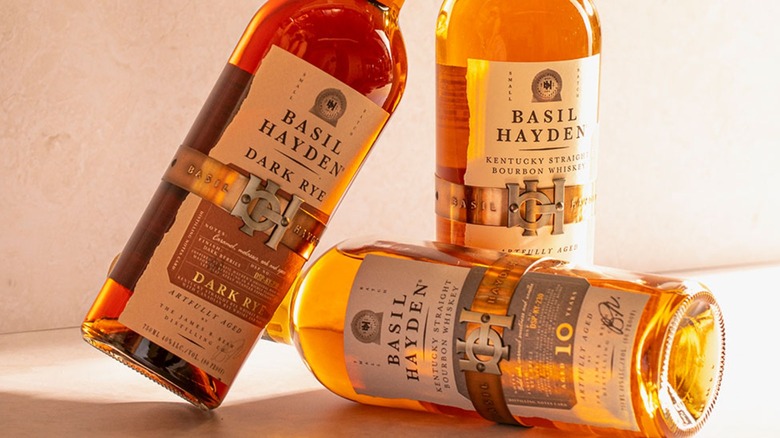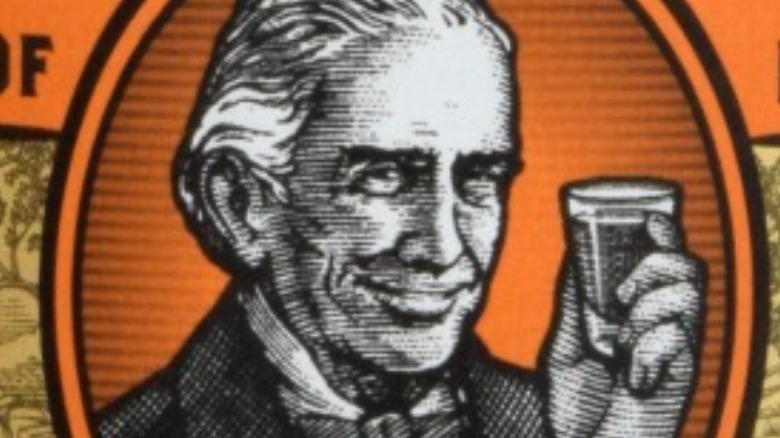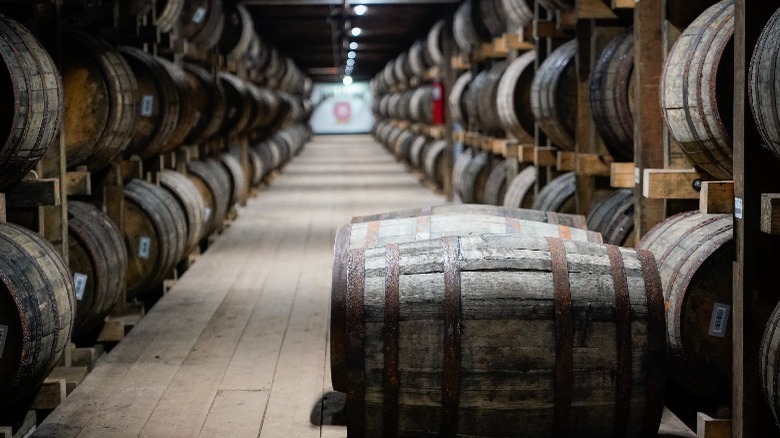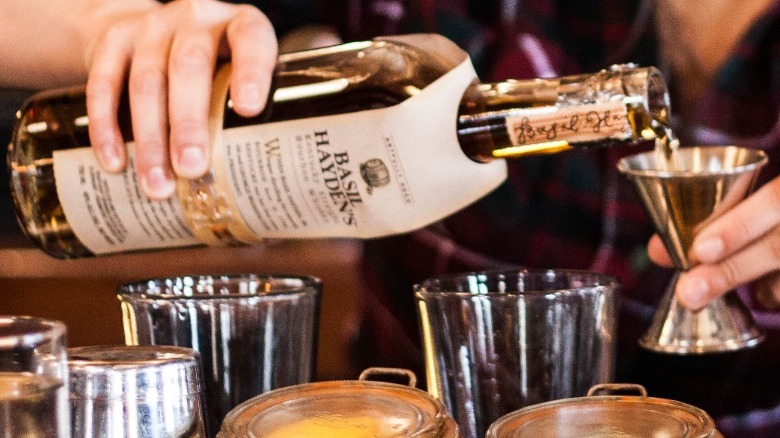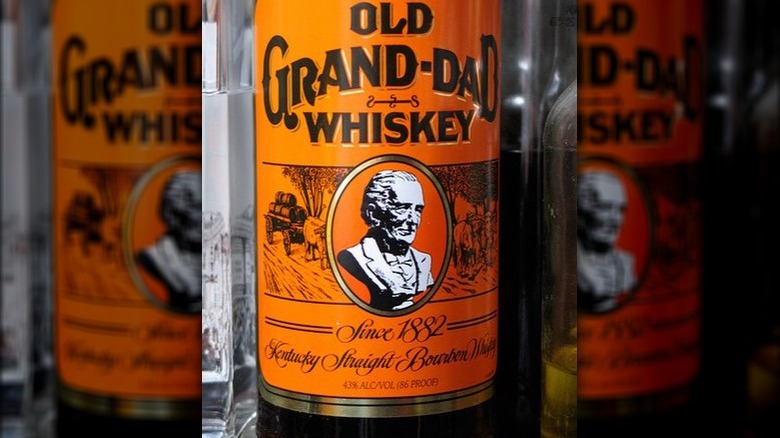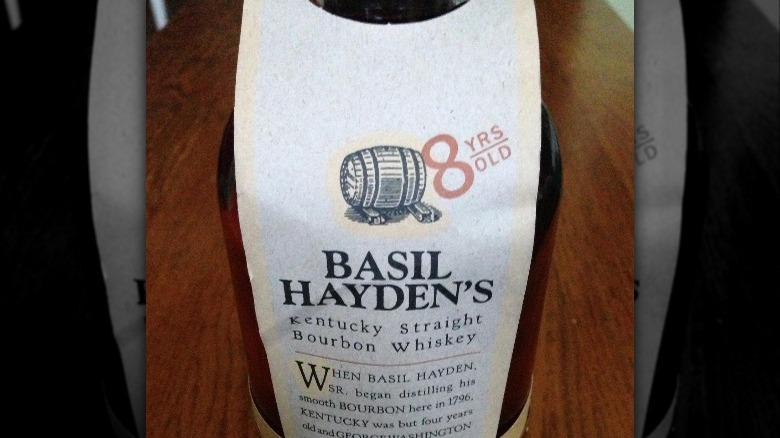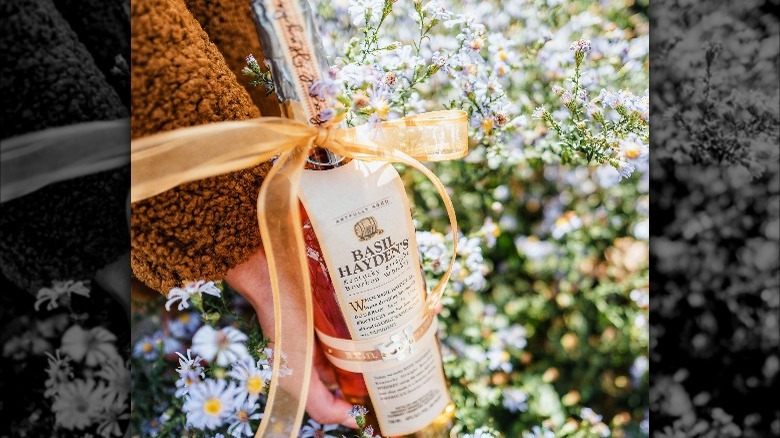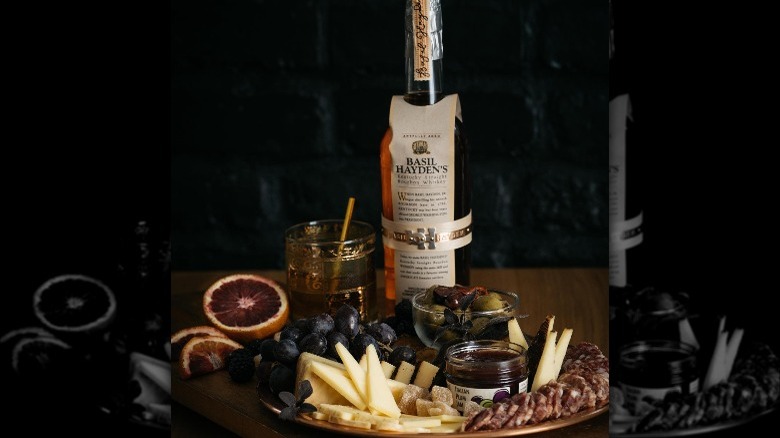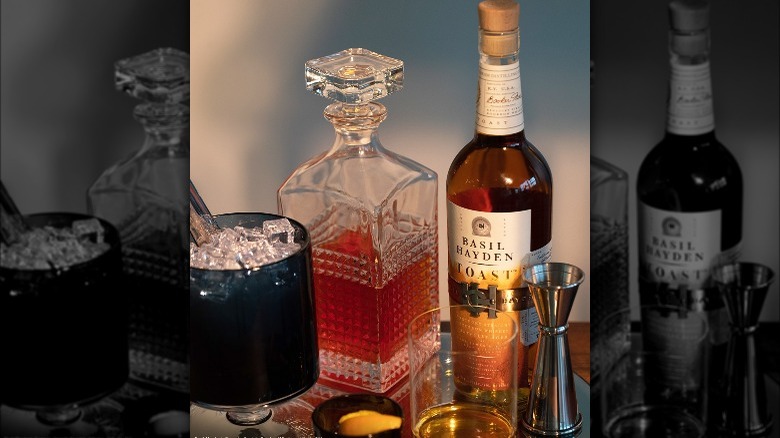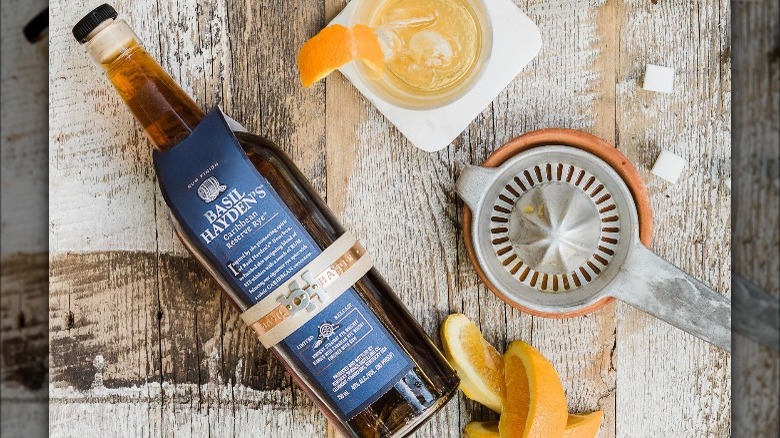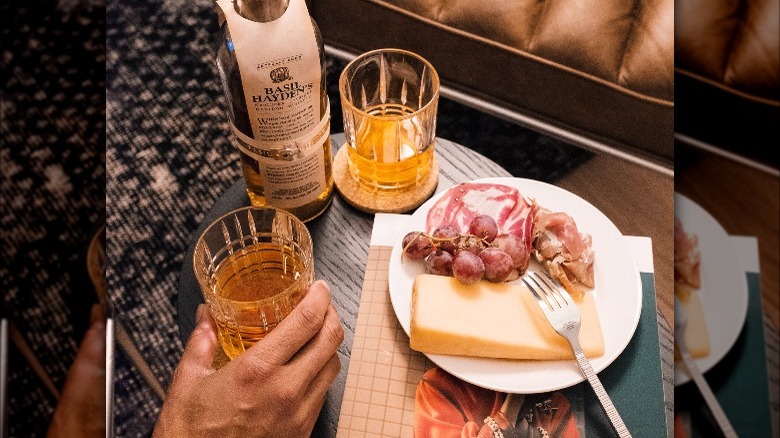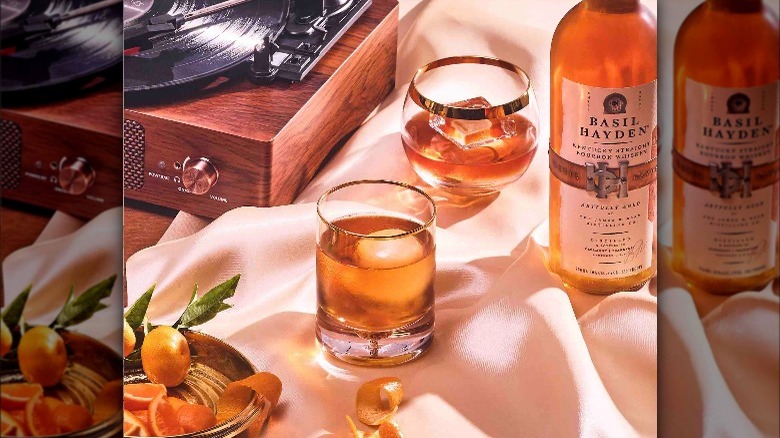What To Know Before Taking Another Sip Of Basil Hayden
We may receive a commission on purchases made from links.
Basil Hayden was introduced as a premium light bourbon, and it has been that way since 1992. A drink that was birthed in Kentucky's historic Jim B. Beam Distilling Co., it has stood the test of time, never straying away from its 80 proof trademark. In fact, the low alcohol content makes it a smooth and approachable alternative to whiskeys that can be intimidating for new drinkers. "When my grandfather Booker Noe first made Basil Hayden, his intention was always to create bourbon that opened people's minds to what bourbon can be," said Freddie Noe, the sixth generation master distiller of Beam Distillery.
As far as the growth of this particular bough of the giant Beam tree is concerned, it has been pretty successful. Past and recent reports show consistent growth in Basil Hayden's sales, per Bloomberg. The bourbon follows a mash bill that is designed to give it notes of sweet and spice — a recipe (which dates back to the 18th century) that's older than the word "bourbon" (which originated in the 19th century). Though steeped in history, the whiskey is embracing the contemporary. What else could explain the existence of Basil Hayden popsicles? Before taking another sip, learn how the millennial drink is staying relevant by infusing itself in aged cheddars and experimenting fearlessly — be it with its bottle design or core recipe.
Basil Hayden is named after an 18th century distiller
Here's a conversation starter for when you clink your glasses of Basil Hayden: Did you know that the man the whiskey is named after was also behind Kentucky's first Catholic church? Well, if that's too long, put it this way: Did you know Basil Hayden is actually the name of an 18th-century distiller? Because both statements are true, either can make you look like the perfect "Jeopardy!" contestant. As mentioned in the book "Patriarch of the American Frontier," Hayden had led a group of Catholics from Maryland to Kentucky in 1785. Six years later, under a certain reverend who had migrated from North Carolina, the Catholics set up their first church in Kentucky.
Aside from helping establish a place to worship the holy spirit, Hayden had also created a place to make spirit. In 1791, he started a distillery to make bourbon whiskey. To put things into perspective, Jim Beam Distillery only came into existence in 1795. Hayden probably didn't have much competition starting out. However, it should be noted that Potting Creek Settlement — the place that he and his 25-family gang (via Forbes) had moved to from Maryland — is quite close to Bardstown in Nelson County, Ky. Why is this important? Bardstown brims with as many as 11 distilleries, including Jim Beam. Did Hayden have anything to do with it? There, we gave you another conversation starter for your soirée.
Basil Hayden follows a centuries-old recipe
In an age where trends pass like seasons, the fact that a certain bourbon recipe from Kentucky has survived from before Kentucky was even a state (it was in 1792 if you must know), is pretty commendable. According to Basil Hayden's website, the bourbon was inspired by 18th-century distiller Basil Hayden's original recipe. Hayden was a rye farmer who moved from Maryland to Kentucky and started distilling his whiskey quite differently from others. As per whiskey expert Joseph V. Micallef, in the 1780s, Kentucky was used to only corn whiskeys. Since Hayden had come fresh from Maryland, where rye whiskeys were a thing back then, he used a high portion of rye in his whiskeys. This combination of corn and rye is what is used in Basil Hayden today.
But how did a 1700s recipe make it to the TikTok age? It's all thanks to Hayden's grandson Raymond Basil Hayden, who probably referred to his gramps' notes to bring out the popular bourbon Old Grand-Dad in his honor, in 1840. Old Grand-Dad used a high percentage of rye as well, as mentioned in "The Curious Bartender's Whiskey Road Trip." OG Dad and Basil Hayden use the same mash bill: "63% corn, 27% rye and 10% malted barley."
Basil Hayden was created by Jim Beam's grandson
Basil Hayden was introduced by master distiller Booker Noe, who is a sixth generation of the Beam family. Why isn't 'Beam' his last name? Noe is the legendary Jim Beam's eldest grandson. Jim Beam's daughter Margaret had married Frederick Booker Noe (hence the name), who worked at a bank and did not have anything to do with his father-in-law's distillery, as mentioned in "The Big Man of Jim Beam" .
Noe (Fred Booker Noe II was his real name) however was keenly interested, and joined the family business. According to Jim Beam's website, he was known for revitalizing the bourbon category which was in the bear market, by launching a small batch of premium bourbons, among which was the star of this article: Basil Hayden. Other bourbons included Booker's Bourbon, Knob Creek and Baker's. Noe timed the release with his retirement, saying au revoir in style after almost 50 years of working at the Beam distillery.
During Noe's time at the distillery, Jim Beam had acquired the National Distillers' spirit division in 1950. It had included Old Grand-Dad (via Distillery Commons), the whiskey that was made the way master distiller Basil Hayden had made it in the 18th century — with more rye than most bourbons. Almost 42 years since Old Grand-Dad became part of the Beam family, Noe came up with a bourbon that uses a similar high-rye percentage — and that was Basil Hayden.
It has a lot in common with Jim Beam's Old Grand-dad bourbon
Basil Hayden might have come into the market 150 odd years after Old Grand-Dad (introduced in 1840), but it follows the same mash bill as its old chum. In fact, Basil Hayden and Old Grand-Dad are the only two bourbons made in the Beam distillery that use a high-rye bourbon mash (63% corn, 27% rye, and 10% barley), as mentioned in "The Curious Bartender's Whiskey Road Trip." This is different from the mash bill used in other whiskeys made at Jim Beam's distillery. For example, Jim Beam White Label and Knob Creek use the standard bourbon mash bill (13% rye), and others like Old Overholt and Jim Beam Rye use a rye mash bill (over 50% rye).
Besides being mash bill twins, both taste similar to some (via Reddit), and their names are an ode to the same man: Meredith Basil Hayden, who is credited to have inspired both the poisons. He is the face you see on every Old Grand-Dad bottle. Though there is a ton in common, Basil Hayden advertises itself as a premium spin on the Old Grand-Dad. A bottle of Basil Hayden is $54, way higher than an Old Grand-Dad which is $35 (via Wine Searcher). Basil Hayden's bottle does look a tad posher than its ancestor's bottle, and as mentioned in the book "Bourbon at its Best," "it spends a little more time in barrels than Old Grand-Dad."
Basil Hayden bottles used to have an age statement
Basil Hayden in the past had no qualms about revealing its age. Its bottles clearly mentioned that the whiskey inside it was aged for eight years, per "American Whiskey." As of 2014, according to Liquor, this age statement was replaced by a vague "Artfully Aged." But how does one quantify "artfully?" A Redditor wrote that hiding the age meant there's "nothing certain," and that it might as well contain some "basic 2 year old straight" in it — until they were corrected by another Redditor, who explained that the whiskey used in a "No Age Statement" bourbon should be at least four years old. And they are right — it's the law, as per Liquor.
It is a misconception that a No Age Statement (NAS) whiskey is inferior to one that mentions the age, as per Joel Hauer, founder of the whiskey subscription service, Whisky Loot. NAS doesn't mean that the whiskey is of low quality or hasn't been aged at all — what it means is that it is a blend of a range of whiskeys of different ages. "NAS whisky can be every bit as tasty and sophisticated as aged whisky, and it has open the floodgates for whisky distillers to experiment with new blends that can revolutionize the whisky-drinking experience!" he said on Whisky Loot. Also, dropping the age on a bottle allows the distiller to focus on other aspects such as "color, flavor and technique."
Basil Hayden has won awards for its taste
Basil Hayden's bourbon has been called the "smoothest, most drinkable bourbon" and "very enjoyable" by its fans (via Master of Malt). Adding to the validation from its customers, the drink has gone on to bag an array of awards that attest to its winning taste. Whiskey expert Charles MacLean, in his book, "Great Whiskeys", listed Basil Hayden as one among the 500 of the best from around the world. While making the list, MacLean wrote that he had help from other connoisseurs, including Scottish whiskey expert Dave Broom, Edinburgh-based whiskey writer Tom Bruce-Gardyne, and Ian Buxton, author of "The first definition book on Whisky," among others. Basil Hayden earned a spot on the list based on all their collective expert opinions.
Basil Hayden's rye whiskey won the double gold in the 2017 New York International Spirits Competition, and its straight bourbon won the gold in the same competition in 2020, while nabbing another double gold in San Francisco World Spirits Competition 2020. Also resting in Basil Hayden's kitty is a gold from American Spirits Council of Tasters (ASCOT) 2021. The drink was among the 600 entries that were adjudged for color, aroma, taste, and finish, by judges including rum and cocktail expert and co-author of James Beard Award-winning book "Smuggler's Cove: Exotic Cocktails, Rum, and the Cult of Tiki", Martin Cate; and founder of Bourbon Women's Association and 2019 Kentucky Bourbon Hall of Famer, Peggy Noe Stevens.
Basil Hayden was an ingredient in an award-winning cheese
Here's a cheese that will go well with your Basil Hayden straight bourbon: a cheese infused with the same spirit. Utah-based Beehive Cheese and Basil Hayden joined hands to come up with a bourbon-infused cheese named, "Pour me a slice." As per the Beehive Cheese website, this spirited creation — launched in 2019, right before the holiday season — is "sweet and creamy with a hint of bourbon spice." The aged cheddar cheese, made with vegetarian rennet, cow's milk, and Basil Hayden's straight bourbon, goes well with soup, bread, fruit, or crackers, per those who reviewed the product on the website.
According to Christopher Null, founder of Drinkhacker, a blog that reviews alcoholic beverages, the cheese was "moderately sharp, the whiskey element is elusive, and while notes of vanilla and a hint of charred wood do manage to emerge on the finish, it is heavily overpowered by the more traditional sharp cheddar notes." He added that it was "powerfully tart and a bit salty." The cheese, however, went on to bag the bronze medal at the 2021 World Cheese Awards, which had a total of 4,079 cheese entries from 45 countries (via The New York Times). The 33rd edition of the festival was held in Spain, and as mentioned on the International Cheese Festival website, there were 250 international judges picking out the best.
Basil Hayden deviated from its original recipe
By making an 18th-century recipe cool, Basil Hayden has proven that it's all for traditions. In 2021, however, it made the bold move of shifting from its set recipe for one new expression. Called Basil Hayden Toast Bourbon, the new drink used brown rice instead of rye in its mash bill. While the original mash bill called for 27% rye (besides corn and malted barley), Basil Hayden's Toast used 27% brown rice (via Forbes). The result was a drink that had less spice — a taste which the rye brings in — and more notes of sweetness. It also had an increased depth of flavor, which was brought by "secondary aging in a toasted then flash-charred oak barrel," as mentioned on the website.
Since the bourbon was made to rest in char barrels, there are notes of toasted wood. As per the company, it's a "complex flavor grounded in sweet vanilla and rich roasted nuts." The reviewers on the website called it smooth, with one commenting, "I found it light and refreshing, not like other Hayden offerings. Great sipper for a hot summer day."
Jim Beam Distillery is not new to brown rice bourbons; back in 2014, it released Jim Beam Signature Craft Brown Rice Bourbon, which was 90 proof and aged 11 years. As per the company, it was an experiment that "a group of daring distillers" took up back in 2003.
Many of Basil Hayden's offerings now remain a history
In 2019, Basil Hayden introduced a certain whiskey and rum blend called Caribbean Reserve Rye. According to Basil Hayden's website, the whiskey is a blend of eight-year-old Kentucky straight rye whiskey and four-year-old Canadian rye whisky. To this is added blackstrap rum, a rum made with blackstrap molasses — a common ingredient in most Caribbean rums, per Richard Seale, master distiller of Foursquare Rum in Barbados (via Punch). The drink tastes sweet but also has notes of spice, toasted oak, and vanilla. This was a limited edition product by the company, and now, only rests as an image and description on Basil Hayden's website.
Similarly, Basil Hayden's Two by Two Rye, which Men's Journal referred to as something you can sip before breakfast and continue nursing through the day, was released as a limited edition rye in 2018. As per the journal, the drink was a blend of two ryes, aged five and seven years, and two bourbons, aged seven and 13 years. Despite the exhilarating feedback from customers, Basil Hayden's Two by Two Rye stayed on for just two ticks.
Today, Basil Hayden offers bourbon, dark rye, 10-year bourbon, and toast (via Basil Hayden). Its 10-year bourbon, which is aged in newly-charred American oak barrels, was first released in 2018, before appearing again in the market as a limited-edition offering in 2020 (via Thrillist).
Basil Hayden is perfect for new whiskey drinkers
Jim Beam Distillery introduced Basil Hayden with other small-batch bourbons, such as Knob Creek and Baker's. Each was known for its unique characteristic — as per Gear Patrol, Baker's, at 130 proof, was targeted toward veteran whiskey drinkers; and Knob Creek, at 100 proof, was the best value bourbon. Then there was Basil Hayden, whose reputation, per "American Whiskey," was being the "lightest member" in the small batch release. At 80 proof, the "light, easy-drinking qualities" of the drink are what attracted casual drinkers to it, according to Richard Thomas of "American Whiskey." Thrillist points out that the low proof of Basil Hayden makes it a good alternative to Old Grand-Dad (available in 80, 100, 114 proof), which can seem a little rough for those who aren't used to the whiskey burn.
"I would choose Basil Hayden's as a good beginner bourbon ... It's very smooth and easy drinking," bartender Bryan Walls told Liquor). Having said that, some critics find it too highly-priced compared to other 80-proof bourbons. Old Grand-Dad, which has the same mash bill as Basil Hayden but a higher proof, costs only half as much (via Liquor). Whiskey expert Joseph V. Micallef refers to Basil Hayden's low proof as a drawback: "A few additional years of aging and the higher proof would make it much more flavorful and complex."
Basil Hayden went through a rebrand
Basil Hayden used to be called "Basil Hayden's." While it lost the baggage that was the apostrophe, it also got quite a makeover. Along with launching a brand new mashbill that replaced rye with brown rice, the company revamped its bottle design. Some of the changes, as mentioned in Men's Journal, include the replacement of the foil cap with a wooden one. The neck of the bottle now sports a label, which has the name of founding distiller Booker Noe embossed in gold letters. The belt — a Basil Hayden trademark, which has the letters "B" and "H" monogrammed on it, inspired from the metal hoops that are used to hold a barrel together — is wider on the new bottles.
The company called the change a "sophisticated, design-forward packaging update," and rolled it out mid-2021. Customers, of course, did notice the update. A Redditor posted, "The metal bh belt makes it look like it came out of a vintage Tim Burton movie or a steampunk bar." But a few others were not too pleased. One referred to it as "weird," and another said, "The bottle gimmick was kinda dumb before. This looks even worse."
